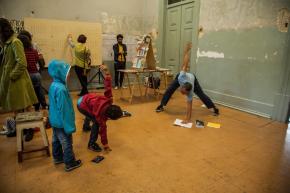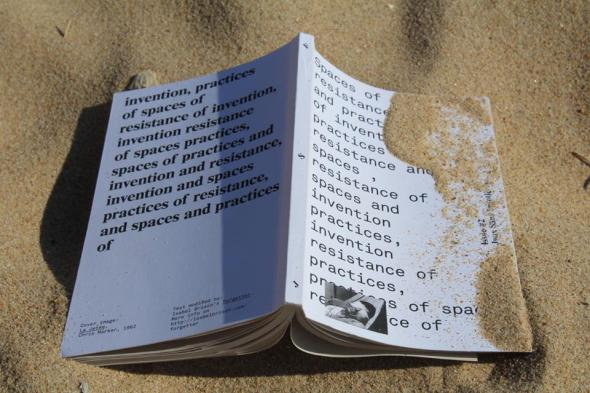It's a knockout!
is a 2 day program curated by Jeux Sans Frontières for ART IN RESISTANCE at Spielart festival 2015.
Resonating with and responding to the current moment - when borders, rather than disappearing, seem to disseminate - IT’S a KNOCKOUT is structured in 2 events thought of as complementary and intertwined:
30/10: FILM + DEBATE
Bab Septa filmscreening (directors Pedro Pinho and Frederico Lobo) + discussion on Schegen and the border South of Europe with Ana Bigotte Vieira and Sandra Lang moderated by Tania el Khoury. Presentation of magazine JSF#1
1/11: PERFORMANCE + DEBATE
 Miguel Pereira’s Resistance Solo + discussion of Practices of Resistance and Practices of Invention. Presentation of magazine JSF#2 by invited guest Jacopo Galimberti and editors Ana Bigotte Vieira, Sandra Lang and Nuno Leão
Miguel Pereira’s Resistance Solo + discussion of Practices of Resistance and Practices of Invention. Presentation of magazine JSF#2 by invited guest Jacopo Galimberti and editors Ana Bigotte Vieira, Sandra Lang and Nuno Leão
Rather than simplify or give quick explanations, the 3 events aim at making affectively visible to the audience the complexity of phenomena such as global migration movements, EU politics and urban wealth distribution.
FILM | Bab Septa, Pedro Pinho and Frederico Lobo (directors)
In Arabic, Bab Septa means “Ceuta’s gate” and it’s the name of the passage in the border of Morocco and Ceuta. This is the place of convergence of those who, coming from several parts of Africa, hope to reach Europe. The film Bab Septa visits four cities meeting the times of waiting and the voices of these travelers.Pinho and Lobo collaborated magazine JSF#1, where the film directors intention note was published and publicly discussed. The documentary circulated al over the world having won several awards, among witch the prizes BEST DOC DOCLISBOA 2008, PRIX ESPéRANCE FID 2008, among others.
PERFORMANCE | Resistance Solo
Miguel Pereira, O rumo do fumo
Miguel Pereira’s Resistance Solo is a performance/installation in which the dancer and choreographer Miguel Pereira exercises, over about 3 hours, the limits of physical and mental resistance. When invited by J_S_F to make an intervention on the concept of ‘resistance’ Pereira chose to work on the limits of both physical and intellectual resistance: resisting solo. Thus, the choreographer reads complex texts continuously whilst simultaneously moving – stretching arms and words, legs and thoughts. What started as an ironic literal way of addressing “resistance”, ended up being a piece on endurance and exhaustion. Miguel Pereira literally embodies our fragile condition of having to be both physically and theoretically fit in order to deal with what’s going on, while it is going on.
BOOK LAUCH | JSF#2 on practices of resistance and spaces of invention
Ana Bigotte Vieira, Sandra Lang, Nuno Leão (editors)
J-S-F Issue #2 gathers a series of contributions under the title “practices of resistance and spaces of invention”.The subtitle of this issue works both ways: practices of resistance and spaces of invention, practices of invention and spaces of resistance. Even if we think in terms of productive power relations, we still use the word “resistance” in reference to those practices and spaces that emerge in moments of antagonist tension: e.g., when measures imposed by governmental institutions and the lack of perspectives for the future are individually and collectively felt as being oppressive. But to resist – r/esistere in a somewhat fictional etymology – also means to invent new modes of existence. To invent is not to create something out of nothing, but to aggregate forces that were already present – the invention in this sense is a recomposition of forces.In J-S-F #2 we decided to speak about realities and imaginary zones, moments and desires that emerge when people do not accept the state of things, such as the way current neoliberal politics work and the ways in which we function within that framework. Moments of rupture can emerge everywhere and practices of resistance spread beyond national frontiers. The texts here were written between 2012 and 2014. Considering the local differences – NYC, Rabat, Madrid, S. Paulo, Lisboa, Athens – we may try to ask ourselves how and where those practices might resonate.

Jeux Sans Frontières (J-S-F) is a transdisciplinary platform, working at the intersection of art, theory and politics and producing events that resonate with their contexts of emergence and presentation. Besides producing and curating discussions, film screenings, performances and artworks, J-S-F produces a print magazine on art, social movements and critical theory. J-S-F magazine had two editions so far: J-S-F #1 (2007) on the construction of Europe from the viewpoint of exclusion and the Schengen borders, and J-S-F #2 (2015) on ‘spaces of resistance and practices of invention’ throughout Europe and beyond. The magazine is thought of as an object to circulate and promote discussion. J-S-F takes its name from Jeux Sans Frontières - the longest transmission in the history of European television co-production.
More info:
http://www.buala.org/en/games-without-borders